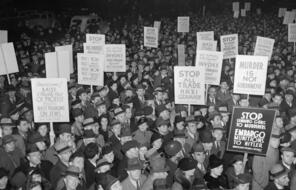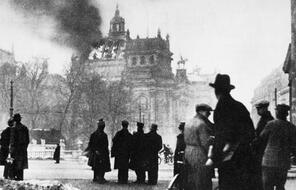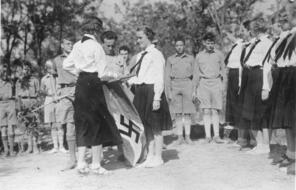A Refugee Crisis
Subject
- History
Language
English — USUpdated
The incorporation of Austria into the Third Reich spelled terror for the 200,000 Jews in that country, as an account in a London newspaper reported:
It is the heartless, grinning, soberly dressed crowds on the Graben and the Karntnerstrasse [streets in Vienna] . . . fluffy Viennese blondes, fighting to get closer to the elevating spectacle of an ashen-faced Jewish surgeon on his hands and knees before half a dozen young hooligans with Swastika armlets and dog-whips, that sticks in my mind. His delicate fingers, which must have made the swift and confident incisions that had saved the lives of many Viennese, held a scrubbing brush. A storm trooper was pouring some acid solution over the brush—and his fingers. Another sluiced the pavement from a bucket, taking care to drench the surgeon's striped trousers as he did so. And the Viennese—not uniformed Nazis or a raging mob, but the Viennese Little Man and his wife—just grinned approval at the glorious fun. 1
Within weeks of the Anschluss, foreign journalists in Austria were reporting hundreds of similar antisemitic incidents throughout the nation. Some noted a sharp increase in suicides, as thousands of Jews tried desperately to emigrate only to encounter roadblocks wherever they turned. Their difficulty in leaving “Greater Germany” was not with the Nazis, who, faced with the problem of including an additional 200,000 Jews in the Reich, were eager to see Jews leave the country as long as they left their money and other possessions behind. The problem was with other nations, most of whom had no interest in accepting thousands of penniless Jewish refugees.
Between 1,500 and 3,500 Austrian Jews applied for immigration visas to come to the United States in the days following the Anschluss. President Franklin Roosevelt was sympathetic to their plight but believed he did not have the public’s support to ask Congress to change the quota system under which immigrants were admitted. A poll published in Fortune magazine in 1938 reveals much about public opinion in the United States (see table 1). 2
Attitudes toward Allowing German, Austrian, and Other Political Refugees into the United States, July 1938
We should encourage their arrival even if our immigration quotas are raised. 4.9%
We should allow their arrival but not raise our immigration quotas. 18.2%
Given our current conditions, we should keep them out. 67.4%
I don’t know. 9.5%
Source: Fortune magazine, July 1938.
Acting on his own, Roosevelt did combine the Austrian and German quotas that, together, would allow more than 7,000 Jewish refugees to enter. In addition, Roosevelt called for an international conference to discuss the growing refugee crisis. Many nations were reluctant to attend, even though the Americans assured them that no country would be expected to “receive a greater number of emigrants than is permitted by its existing legislation.” 3
Canada was among those reluctant nations. Prime Minister Mackenzie King wrote in his diary, “We must . . . seek to keep this part of the Continent free from unrest and from too great an intermixture of foreign strains of blood.” In his view, nothing was to be gained “by creating an internal problem in an effort to meet an international one.” 4
Nevertheless, in July 1938, delegates from 32 nations, including Canada, met in Evian, France. They were joined by representatives from dozens of relief organizations and other groups, as well as hundreds of reporters. At the conference, each delegate formally expressed sorrow over the growing number of “refugees” and “deportees,” boasted of his nation’s traditional hospitality, and lamented that his nation was unable to do more in the “present situation.”
The British, noting that many refugees wanted to go to Palestine, which was then under British rule, said they would like to admit more refugees, but in view of the ongoing conflict between Arabs and Jews, it was not a practical solution. The French claimed that their country had already done more than its fair share. The Americans noted that Congress would have to approve any change in the nation’s immigration laws—legislation that set a limit on the number of immigrants the United States would accept from each country each year.
Historians Richard Breitman and Allan Lichtman describe the responses of other countries at the conference:
Nicaragua, Costa Rica, Honduras, and Panama stated that they wanted no traders or intellectuals, code words for Jews. Argentina said it had already accommodated enough immigrants from Central Europe. Canada cited its unemployment problem. Australia said that it had no “racial problems” and did not want to create any by bringing in Jewish refugees. Imperial countries such as Britain, France, and the Netherlands said that their tropical territories offered only limited prospects for European refugees. League of Nations High Commissioner Sir Neill Malcolm was openly hostile to the idea of a new refugee organization . . . The Washington Post headlined one story on the conference, “YES, BUT—.” It noted, “it has been a disappointment, if not altogether a surprise . . . that delegates take the floor to say, We feel sorry for the refugees and potential refugees but—.” 5
The Dominican Republic was the only country that agreed to accept Jewish immigrants. In 1937, the nation’s leader, Rafael Trujillo, had ordered his soldiers to massacre thousands of Haitians at the Dominican border. Historians believe he hoped that accepting Jewish refugees might repair his image internationally. He also hoped that Jews would marry local inhabitants and “lighten” the population. He granted visas to a thousand Jews who were to live in Sosúa, a special community established for them.
Only M. J. M. Yepes of Colombia addressed the real issue at the Evian conference. Yepes was a professor who also served as the legal advisor to his country’s permanent delegation to the League of Nations. He told delegates that there were two central questions that they must confront. One was a question of fact that each nation had to answer for itself: How many refugees would it admit? The other question involved a matter of principle: “Can a State, without upsetting the basis of our civilization, and, indeed, of all civilization, arbitrarily withdraw nationality from a whole class of its citizens, thereby making them Stateless Persons whom no country is compelled to receive on its territory?” 6
Yepes went on to say that as long as that central problem was not decided, the work of the conference would not be lasting and a dangerous example would be set—an example that in his view would make the world “uninhabitable.” But most delegates did not want to deal with either issue. 7
The Jewish observer from Palestine, Golda Meyerson, who would become prime minister of Israel many years later (as Golda Meir), was not allowed to speak. She wrote:
I don’t think that anyone who didn’t live through it can understand what I felt at Evian—a mixture of sorrow, rage, frustration, and horror. I wanted to get up and scream at them, “Don’t you know that these so-called numbers are human beings, people who may spend the rest of their lives in concentration camps, or wandering around the world like lepers if you don’t let them in?” Of course, I didn’t know then that not concentration camps but death camps awaited the refugees whom no one wanted. 8
Connection Questions
- How did the Anschluss lead to a refugee crisis?
- How did other countries respond to the refugee crisis? What reasons did they give? What determined whether or not countries were willing to accept Jewish refugees?
- How would you interpret the Fortune poll taken in July 1938? What does it suggest about the United States’ universe of obligation at the time?
- What is the significance of being a “stateless person”? What does it mean for a nation to withdraw nationality from a group? What are the consequences for individuals when they no longer belong to any nation?
- What responsibility do countries have to refugees coming from outside their borders? What factors should the leaders of countries consider when deciding how to respond to a refugee crisis?
- 1Quoted in Giles MacDonogh, 1938: Hitler's Gamble (New York: Basic Books, 2009), 46.
- 2Ishaan Tharoor, “What Americans thought of Jewish refugees on the eve of World War II,” Washington Post, November 17, 2015, accessed June 29, 2016.
- 3Quoted in Irving Abella and Harold Troper, None Is Too Many: Canada and the Jews of Europe, 1933–1948 (New York: Random House, 1983), 17.
- 4Quoted in Irving Abella and Harold Troper, None Is Too Many: Canada and the Jews of Europe, 1933–1948 (New York: Random House, 1983), 17.
- 5Richard Breitman and Allan J. Lichtman, FDR and the Jews (Cambridge, MA: Belknap Press of Harvard University Press, 2013), 109.
- 6Debórah Dwork and Robert Jan van Pelt, Flight from the Reich: Refugee Jews, 1933–1946 (New York: W. W. Norton, 2009), 100.
- 7Debórah Dwork and Robert Jan van Pelt, Flight from the Reich: Refugee Jews, 1933–1946 (New York: W. W. Norton, 2009), 100.
- 8Golda Meir, My Life (New York: G. P. Putnam’s Sons, 1975), 158.
How to Cite This Reading
Facing History & Ourselves, “A Refugee Crisis”, last updated August 2, 2016.












